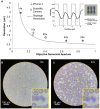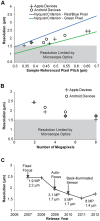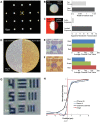Quantitative imaging with a mobile phone microscope
- PMID: 24824072
- PMCID: PMC4019540
- DOI: 10.1371/journal.pone.0096906
Quantitative imaging with a mobile phone microscope
Abstract
Use of optical imaging for medical and scientific applications requires accurate quantification of features such as object size, color, and brightness. High pixel density cameras available on modern mobile phones have made photography simple and convenient for consumer applications; however, the camera hardware and software that enables this simplicity can present a barrier to accurate quantification of image data. This issue is exacerbated by automated settings, proprietary image processing algorithms, rapid phone evolution, and the diversity of manufacturers. If mobile phone cameras are to live up to their potential to increase access to healthcare in low-resource settings, limitations of mobile phone-based imaging must be fully understood and addressed with procedures that minimize their effects on image quantification. Here we focus on microscopic optical imaging using a custom mobile phone microscope that is compatible with phones from multiple manufacturers. We demonstrate that quantitative microscopy with micron-scale spatial resolution can be carried out with multiple phones and that image linearity, distortion, and color can be corrected as needed. Using all versions of the iPhone and a selection of Android phones released between 2007 and 2012, we show that phones with greater than 5 MP are capable of nearly diffraction-limited resolution over a broad range of magnifications, including those relevant for single cell imaging. We find that automatic focus, exposure, and color gain standard on mobile phones can degrade image resolution and reduce accuracy of color capture if uncorrected, and we devise procedures to avoid these barriers to quantitative imaging. By accommodating the differences between mobile phone cameras and the scientific cameras, mobile phone microscopes can be reliably used to increase access to quantitative imaging for a variety of medical and scientific applications.
Conflict of interest statement
Figures







References
-
- Razdan S, Johannes J, Kuo RL, Bagley DH (2006) The camera phone: a novel aid in urologic practice. Urology 67: 665–669. - PubMed
-
- Yamada M, Watarai H, Andou T, Sakai N (2003) Emergency Image Transfer System through a Mobile Telephone in Japan: Technical Note. Neurosurgery 52: 986–990. - PubMed
-
- Kroemer S, Frühauf J, Campbell TM, Massone C, Schwantzer G, et al. (2011) Mobile teledermatology for skin tumour screening: diagnostic accuracy of clinical and dermoscopic image tele-evaluation using cellular phones. Br J Dermatol 164: 973–979. - PubMed
-
- Frean J (2007) Microscopic images transmitted by mobile cameraphone. Trans R Soc Trop Med Hyg 101: 1053. - PubMed
Publication types
MeSH terms
LinkOut - more resources
Full Text Sources
Other Literature Sources
Medical

